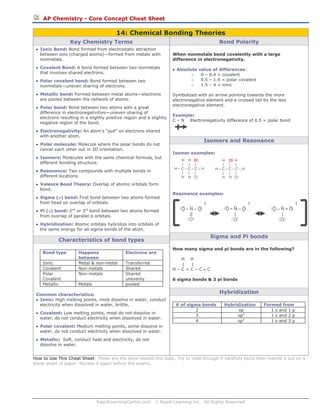
Chemical bondingtheories cheat sheet
- 1. AP Chemistry - Core Concept Cheat Sheet 14: Chemical Bonding Theories Key Chemistry Terms Bond Polarity • Ionic Bond: Bond formed from electrostatic attraction between ions (charged atoms)—formed from metals with nonmetals. • Covalent Bond: A bond formed between two nonmetals that involves shared electrons. • Polar covalent bond: Bond formed between two nonmetals—uneven sharing of electrons. • Metallic bond: Formed between metal atoms—electrons are pooled between the network of atoms. • Polar bond: Bond between two atoms with a great difference in electronegativities—uneven sharing of electrons resulting in a slightly positive region and a slightly negative region of the bond. • Electronegativity: An atom's “pull” on electrons shared with another atom. • Polar molecule: Molecule where the polar bonds do not cancel each other out in 3D orientation. • Isomers: Molecules with the same chemical formula, but different bonding structure. • Resonance: Two compounds with multiple bonds in different locations. • Valence Bond Theory: Overlap of atomic orbitals form bond. • Sigma (σ) bond: First bond between two atoms formed from head on overlap of orbitals. • Pi (π) bond: 2nd or 3rd bond between two atoms formed from overlap of parallel p orbitals. • Hybridization: Atomic orbitals hybridize into orbitals of the same energy for all sigma bonds of the atom. Ionic Covalent Polar Covalent Metallic Happens between Metal & non-metal Non-metals Non-metals Metals • Absolute o o o value of differences: 0 – 0.4 = covalent 0.5 – 1.4 = polar covalent 1.5 – 4 = ionic Symbolized with an arrow pointing towards the more electronegative element and a crossed tail by the less electronegative element. Example: C – N Electronegativity difference of 0.5 = polar bond Isomers and Resonance Isomer examples: H H Cl | | | H–C–C–C–H | | | H H Cl H Cl H | | | H–C–C–C–H | | | H H Cl Resonance examples: 1 . . .. . O – N – .. . . .. O .. . || . O. . . 1 .. .. . O = N – ... . O ... | . O. . . .. 1 . . .. . O – N = .. . .. . O. | . O. . . .. Sigma and Pi bonds Characteristics of bond types Bond type When nonmetals bond covalently with a large difference in electronegativity. Electrons are How many sigma and pi bonds are in the following? H H | | H–C=C–C≡C Transferred Shared Shared unevenly pooled 6 sigma bonds & 3 pi bonds Common characteristics: • Ionic: High melting points, most dissolve in water, conduct electricity when dissolved in water, brittle. • Covalent: Low melting points, most do not dissolve in water, do not conduct electricity when dissolved in water. Hybridization # of sigma bonds 2 3 4 Hybridization sp sp2 sp3 Formed from 1 s and 1 p 1 s and 2 p 1 s and 3 p • Polar covalent: Medium melting points, some dissolve in water, do not conduct electricity when dissolved in water. • Metallic: Soft, conduct heat and electricity, do not dissolve in water. How to Use This Cheat Sheet: These are the keys related this topic. Try to read through it carefully twice then rewrite it out on a blank sheet of paper. Review it again before the exams. RapidLearningCenter.com © Rapid Learning Inc. All Rights Reserved
